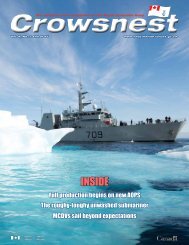Create successful ePaper yourself
Turn your PDF publications into a flip-book with our unique Google optimized e-Paper software.
maritime patrol aircraft in controversial budget cuts four years earlier. 442 <strong>The</strong> latter action created<br />
a strategic capability gap for which no national <strong>of</strong>fset was at that time, or is yet, available. 443<br />
It is not only <strong>the</strong> reduction <strong>of</strong> capabilities available for operations that downsized navies must<br />
confront, for <strong>the</strong> administrative challenge <strong>of</strong> maintaining a much reduced fleet becomes ever<br />
more difficult for naval planners. Longer deployments, a possible consequence <strong>of</strong> fewer ships,<br />
will likely create strains in personnel management including new pressures on retention. In some<br />
naval trades, loss <strong>of</strong> well-trained personnel will impact both an individual ship’s performance at<br />
sea, but could undermine <strong>the</strong> resilience <strong>of</strong> <strong>the</strong> navy as a whole. Innovative approaches to<br />
personnel <strong>and</strong> training hold out <strong>the</strong> possibility <strong>of</strong> mitigating some <strong>of</strong> <strong>the</strong> worst effects <strong>of</strong><br />
downsizing <strong>and</strong> are being tried out in various navies around <strong>the</strong> globe. So far, however, <strong>the</strong> results<br />
are inconclusive <strong>and</strong> perhaps <strong>the</strong>y will remain so for years to come. Reductions in <strong>the</strong> crew size<br />
<strong>of</strong> <strong>the</strong> Littoral Combat Ship (LCS) have none<strong>the</strong>less already led to a reconsideration <strong>of</strong> <strong>the</strong><br />
relationship between advanced technology <strong>and</strong> smaller crews. 444<br />
Last, longer deployments threaten to generate extenuated maintenance cycles that could<br />
negatively affect <strong>the</strong> performance <strong>of</strong> vessels <strong>and</strong> <strong>the</strong>ir crews. According to a report prepared for<br />
<strong>the</strong> USN, <strong>the</strong>re is no evidence that this will result in increased maintenance dem<strong>and</strong>s, but it will<br />
shorten <strong>the</strong> overall service life <strong>of</strong> ships, <strong>and</strong> fur<strong>the</strong>r <strong>the</strong> downward spiral <strong>of</strong> a navy. 445 Unexpected<br />
repairs to ships or even scheduled maintenance will, <strong>the</strong>refore, have a proportionally greater (<strong>and</strong><br />
cascading) impact on a smaller navy that might prove difficult or impossible to redress in <strong>the</strong><br />
event <strong>of</strong> a national emergency. <strong>The</strong> danger is that when a navy has lost critical mass (an<br />
assessment that will necessarily be unique to each country), <strong>the</strong> rationale for <strong>the</strong> maintenance <strong>of</strong><br />
what remains could become increasingly difficult to sustain <strong>and</strong> <strong>the</strong> cost <strong>of</strong> recovery politically<br />
untenable.<br />
Just as navies will need to more rigorously justify <strong>the</strong> retention <strong>and</strong> modernization <strong>of</strong> capabilities<br />
<strong>and</strong> platforms to a country’s political leadership <strong>and</strong>, ideally, general population, downsizing<br />
pressures would seem to urge greater attention be paid to what types <strong>of</strong> missions <strong>the</strong> navy is<br />
expected to undertake. This automatically raises questions for force development regarding <strong>the</strong><br />
requirement for highly-specialized platforms versus more mission-specific, <strong>and</strong> to <strong>the</strong> trade-<strong>of</strong>fs<br />
between capabilities <strong>and</strong> numbers <strong>of</strong> platforms. More to <strong>the</strong> point, while efficiency is likely<br />
always going to be endorsed by public institutions, significant cutbacks in fleet size obviously<br />
impact <strong>the</strong> relevance <strong>of</strong> a navy as an instrument <strong>of</strong> policy. Alongside resilience in wartime, that is<br />
<strong>the</strong> principal danger posed by fleet reduction.<br />
442 Ben Farmer, “Britain forced to ask NATO to track ‘Russian submarine’ in Scottish waters”, <strong>The</strong> Daily<br />
Telegraph, 9 December 2014, <strong>and</strong> Kylie MacLellan, “Britain calls on NATO allies to help in submarine<br />
hunt: media”, Reuters, 10 December 2014.<br />
443 United Kingdom, House <strong>of</strong> Commons Defence Committee, <strong>Future</strong> <strong>Maritime</strong> Surveillance, Volume 1:<br />
Report, toge<strong>the</strong>r with formal minutes, oral <strong>and</strong> written evidence (HMSO: London, 19 September 2012), p. 23.<br />
444 Sam LaGrone, “Report: LCS Manning Could Permanently Increase”, USNI.org, 24 September 2013<br />
[accessed on 1 December 2014 at https://news.usni.org/2013/09/24/report-lcs-manning-permanentlyincrease-2015].<br />
445 Congressional Budget Office, Preserving <strong>the</strong> Navy’s Forward Presence With a Smaller Fleet<br />
(Washington, D.C., March 2015), p. 11.<br />
DRDC-RDDC-2016-R085 89




